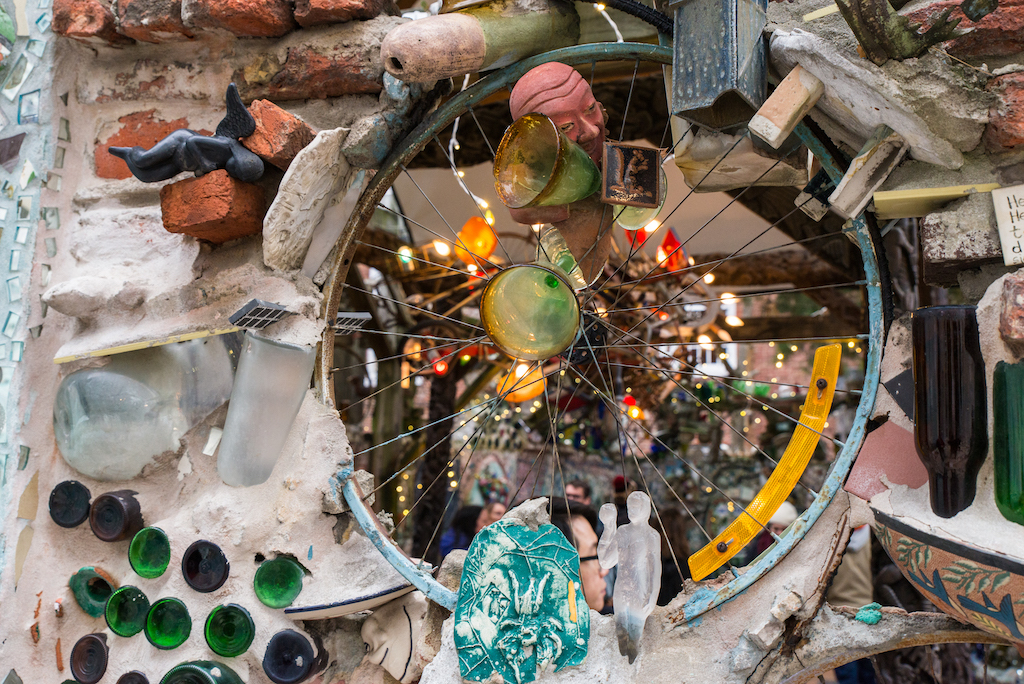Bizarre art and architecture in Philadelphia’s Magic Gardens

Deep in Philadelphia’s South Street neighborhood is a structure — or piece of art, I’m not sure — that absolutely should not exist. It makes no sense. It boggles the mind. And it inspires. But what is one to do with the inspiration?
How the magic gardens came to be
In 1968, the city of Philadelphia planned to demolish a downtrodden neighborhood to make way for a highway. Only an insane person would invest in a place that was doomed.
That person was Isaiah Zagar.
He opened a gallery and decorated it in an idiosyncratic mosaic style. He went on to make mosaics on walls of buildings, featuring an impossible collection of objects and tiles.
Meanwhile, in the wake of public protests, the highway was cancelled. But the neighborhood was still a tough place.
Zagar bought another building next to two vacant lots. He fenced off the lots. And, starting in 1991, he began to build what became Philadelphia’s Magic Gardens.
Frankly, I do not have the appropriate verb to indicate what Zagar does, nor the noun to describe what he creates.
Free from any restrictions of time, space, or convention, Zagar uses mortar, clay, tiles, bottles, dishes, small sculptures, bicycle wheels, and anything else you can imagine to create walls and spaces.
The floors of these spaces are relatively level. The walls suggest rooms or patios. But the rest is riotous and random and irregular and awesome. Zagar challenges whatever you think of as the rules of art. His tiles are sublime and beautiful and in some cases, bawdy. His surfaces explode with texture and color. His mosaics lead you down stairs, into grottos, and into blind alleys. They sparkle. And they defy any sense of sense.
Here’s how it looks, at least insofar as photographs can document something so strange:





What it means
It impossible to “understand” this space. I found it powerful and significant, but I really don’t know what it means.
It is so visually dense, so diverse, and so resistant to perspective, that you really cannot take it in or analyze it. You just sort of have to let it wash over you. I really want to go back, because it creates a Louvre-level of artistic overload — but all created by one artist in one small space.
I certainly got a feel for the artist and his sense of whimsy. It is clear that you cannot build something this ambitious without a plan. But you can only imagine that that plan was written on the backs of old planks of wood and CVS receipts. It hangs together, but has no theme but wild abandon. It is at the edge of threatening, but the humor pulls it away and replaces threat with marvel. As you turn any corner you might find yourself nose to nose with a finely sculpted figurine, a distorted drawing of breast or a penis, a piece of glazed cereal bowl, or a curved mirror showing your own reflection.
At one point I goggled at a mirror broken into many pieces and reglued with stained glass, until my son pointed out that it wasn’t a mirror — the bits were transparent and I could see through them. I mistook the next room for my own face.
My job is to create order and logic in prose. But the world is not order and logic. The world is chaos. We seek to impose patterns upon it, patterns with names like science, art, government, and narrative. Those patterns enable us to exist in the world and imagine that we have some measure of control over it.
Zagar certainly understands logic and architecture at some level, or the “walls” of the garden would topple over. But at another level, he has decided to embrace chaos, to love chaos, to revel in chaos, and to immerse us in his world and force us to experience it and embrace it.
While Zagar was working on the gardens, a man saw him and asked his wife, Julia, “What’s he on?” His wife replied, “Art.” The man was unsatisfied and said “You don’t understand. I mean, what’s he on?” Julia again responded, “Art.”
I don’t know what Zagar has created, but I know it has to continue to exist. And I know you have to go see it. Just leave your desire to understand behind and let it wash over you. It’s worth it.
Thank you for sharing. I have passed it on to my daughter, who is into Arts ;-).
My wife, sister and I stumbled upon Magic Gardens while in Philly for a wedding in late 2018. We too were mesmerized by it. So much so that I had to take a piece home, and I now drink my morning tea from a Magic Gardens cup every day.